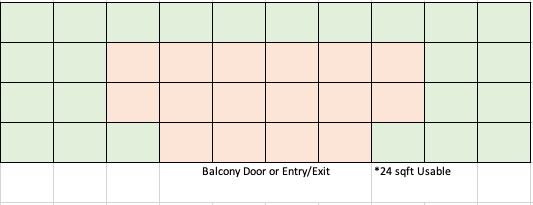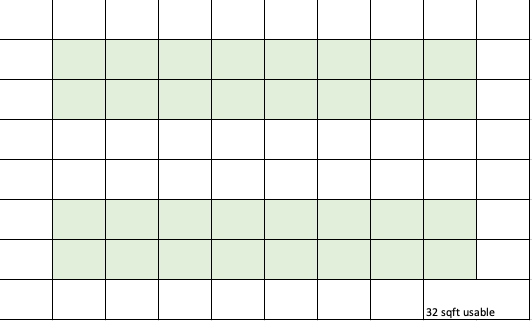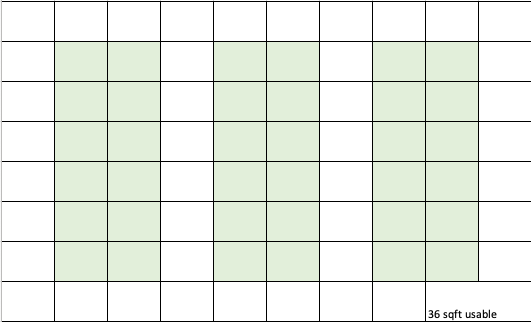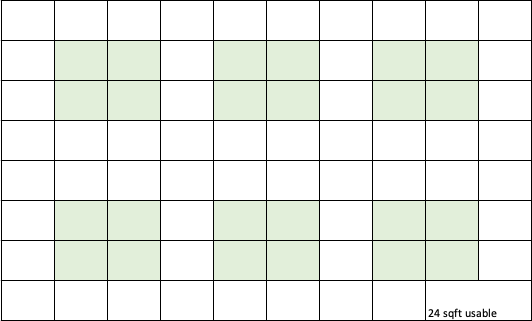An inclusive guide on how to layout a garden in a balcony setting, small backyard setting, or on acreage. In addition to limitations and different needs based on the size of the garden.
How to Layout a Garden for a Balcony
In general, to layout a garden for a balcony, utilize the border of the balcony to place pots, raised beds, or layered shelves. However, consider the amount of weight your balcony can hold before adding several plants.
How Many Square Feet is the Average Balcony?
The average balcony is around 36sqft, based on the average 4ft x 9ft balconies offered by most rental properties. Of the space available on a balcony, 24sqft may be used to grow a garden.

How Much Weight Can Your Balcony Hold?
On average, a balcony will hold 50lbs to 100lbs per square foot. Therefore, a 36sqft balcony should hold 1,800lbs to 3,600lbs of weight. However, check with the building codes at your rental office to get exact measurements and weight limits.
Are There Any Rules or Regulations About Gardening on a Balcony?
Some apartment complexes or rental properties do not permit balcony gardening due to a “cluttered” appearance or the risk of dead plants being unappealing. Fines or charges could be issued if regulations are not followed.
In addition, building garden boxes or trellises on a balcony may not be permitted due to building codes or permits the complex holds in place. However, garden furniture is often allowed on balcony settings and can be used to house small plants.
For specific rules and regulations for your balcony, contact your complex office or the rental officials. Guidelines and permits may be visible on your rental property’s website as well.
How Much Sun Does the Balcony Get?
The direction in which your balcony faces will determine the amount of sun available to you. The sun rising in the east and provides roughly 4 hours of sunlight on the shortest days, and the sun setting in the west and provides roughly 6 hours of sunlight on the shortest days. Therefore, west facing balconies will receive more sunlight. However, the direction of north and south also will affect the amount of sun.
Due to the Earth sitting at an angle to the sun, the south receives more sun than the north. Thus, when deciding what to plant for a garden the direction of your balcony will determine if full sun, partial sun, or full shade is available to you. Keep in mind any obstacles that obstruct light to your balcony, such as other buildings or balconies, trees, carports, landscaping, etc.
Direct North – Shady
North/East – Shady
Direct East – Partial Shade
South/East – Partial Shade
Direct South – Full Sun
South/West – Full Sun
Direct West – Full Sun
How to Choose the Right Plants
Shade Tolerant
Arugula, Endive, Lettuce, Sorrel, Spinach, Kale, Collards, Mustard Greens, Swiss Chard, Beets, Carrots, Potatoes, Radishes, Rutabaga, Turnips, Broccoli, Cauliflower, Brussels Sprouts, Cabbage, Mint, Chives, Cilantro, Oregano, Parsley, Most Herbs
Tip: most plants can be grown in some shade, but they will grow at a slower rate
Full Sun
Heaving fruiting plants like tomatoes, peppers, melons, squash, and berries.
Limits
When choosing plants for your balcony, consider if you have any limits such as time, water availability, mobility, or wildlife that like to visit your balcony.
How to Layout a Garden for a Small Backyard
In general, to layout a garden for a small backyard, utilize raised beds, rows, or garden pots. Garden beds should be accessible from all sides, or shallow enough to reach across. Rows may be one to two feet wide to accommodate a variety of plants. Garden pots are easily portable to move in and out of direct sun or shade.
How Many Square Feet is the Average Small Backyard?
The average small backyard is around 80sqft or 8’x10.’ Although not all properties are square and easy to layout, majority of backyards can hold one to three garden beds with no issue. For example, the white spaces are walkways, the green is garden space. There are a few different layouts that will work in the average backyard. Raised beds, or in-ground gardening could be used in these layouts.




How Much Sun Does Your Backyard Get?
Much like balconies, small backyards may be limited to sun and be very shady. The sun will be more prevalent in a backyard than balcony due to the larger amount of surface area. However, large trees, fence lines, and other homes can obstruct the suns path into your yard. Like balconies, the same sun will apply.
Direct North – Shady
North/East – Shady
Direct East – Partial Shade
South/East – Partial Shade
Direct South – Full Sun
South/West – Full Sun
Direct West – Full Sun
In Ground vs. Raised Beds vs Pots
When laying out your small backyard for gardening, there are three main ways to plant your garden: in ground, raised beds, and garden pots. In ground planting can take any shape from rows to squares to circles. In ground gardening is the least expensive.
Raised beds are typically square or rectangle in shape and can be built or bought depending on the price range of the buyer. Typically, raised beds are 2’ to 4’ deep and 4’ to 10’ long. Taller raised beds are more ergonomic or body friendly, but cost more to fill with dirt. Shorter raised beds are cheaper but require kneeling or bending to plant/harvest.
Pots come in a wide range or size, color, and material, which benefit the buyer based on what they are trying to garden. Terracotta is the “common” garden pot most readily available, but other types of pots include grow bags, ceramic, plastic, and wood. Pots range from seedling size to 50 gallons. In addition, pots are portable and can be moved to follow the sun or moved to provide shade.
How to Choose the Right Plants
Shade Tolerant
Arugula, Endive, Lettuce, Sorrel, Spinach, Kale, Collards, Mustard Greens, Swiss Chard, Beets, Carrots, Potatoes, Radishes, Rutabaga, Turnips, Broccoli, Cauliflower, Brussels Sprouts, Cabbage, Mint, Chives, Cilantro, Oregano, Parsley, Most Herbs
Tip: most plants can be grown in some shade, but they will grow at a slower rate.
Full Sun
Heaving fruiting plants like tomatoes, peppers, melons, squash, corn, and berries.
Limits
When choosing plants for your backyard, consider if you have any limits such as time, water availability, mobility, or wildlife that like to visit. Some backyard gardens may need to be fenced off to prevent deer, squirrels, rabbits, or bears from looting its contents.
How to Layout a Garden for a ¼ Acre
In general, to layout a garden for a quarter acre, utilize raised beds, or rows. Garden beds should be accessible from all sides, or shallow enough to reach across. Rows may be one to two feet wide to accommodate a variety of plants. Garden pots may also be used for smaller plants and are easily portable to move in and out of direct sun or shade.
How Many Square Feet is a ¼ Acre Garden?
A quarter acre is 10,890 sqft or roughly 100’x109’ rectangle. Of the +10,000 square feet, you want to leave enough room to walk around your rows or garden beds leaving around 6,000 square feet to be accessible. As seen below, that is about 153 beds that are 4’x10’.

How Much Time Does it Take to Care for a ¼ Acre Garden?
On average, taking care of a ¼ acre garden will require 8 to 12 hours of work a week, or more depending on the type of plants in your garden. High maintenance plants like cauliflower or lettuce will require more attention than low maintenance plants like cactus or okra.
In Ground vs. Raised Beds
When laying out your quarter acre for gardening, there are two main ways to plant your garden: in ground and raised beds. In ground planting can take any shape from rows to squares to circles. In ground gardening is the least expensive. For larger gardens on a quarter acre, rows will provide simple means of irrigation systems and long lines of the same crop.
Raised beds are typically square or rectangle in shape and can be built or bought depending on the price range of the buyer. Typically, raised beds are 2’ to 4’ deep and 4’ to 10’ long. Taller raised beds are more ergonomic or body friendly, but cost more to fill with dirt. Shorter raised beds are cheaper but require kneeling or bending to plant/harvest. For larger gardens, raised beds may be easier if there are multiple people tending to the garden. Beds also provide an open layout to mixing plants together.
How to Choose the Right Plants
Shade Tolerant
Arugula, Endive, Lettuce, Sorrel, Spinach, Kale, Collards, Mustard Greens, Swiss Chard, Beets, Carrots, Potatoes, Radishes, Rutabaga, Turnips, Broccoli, Cauliflower, Brussels Sprouts, Cabbage, Mint, Chives, Cilantro, Oregano, Parsley, Most Herbs
Tip: most plants can be grown in some shade, but they will grow at a slower rate
Full Sun
Heaving fruiting plants like tomatoes, peppers, melons, squash, corn, and berries.
Limits
When choosing plants for your quarter acre, consider if you have any limits such as time, water availability, mobility, or wildlife that like to visit. Fencing a large garden can be expensive but will be necessary in areas with abundant wildlife. In addition, watering a large garden will require a lot of time, or irrigation systems. Also, for larger gardens, be sure to plant taller crops on the north side of the garden as they will provide shade to plants if grown on a southern side.
Trellis/No Trellis
Using a trellis in a large garden may be beneficial to maximize your space. Several varieties of vining squash will grow on a trellis as well as some melons.
Compost
Compost will be a huge factor when growing on a ¼ acre of land. The soil will need to be amended every growing season to promote proper nutrients to growing plants. Reserving a space of your ¼ acre to compost will be beneficial to allow for a cheaper option than buying compost.
How to Layout a Garden for a ½ Acre
In general, to layout a garden for a half-acre, utilize raised beds, or rows. Garden beds should be accessible from all sides, or shallow enough to reach across. Rows may be one to two feet wide to accommodate a variety of plants. Garden pots may also be used for smaller plants and are easily portable to move in and out of direct sun or shade. A ½ acre garden is a large garden and will require more attention and care than smaller gardens.
How Many Square Feet is a ½ Acre Garden?
A half-acre is roughly 21,780 sqft or a 200’x109’ rectangle. Like the quarter acre, not all of the square feet may be used to garden, as pathways and other areas should be dedicated to compost or equipment.
How Much Time Does it Take to Care for a ½ Acre Garden?
On average, 12 to 20 hours a week will be used to take care of a ½ acre garden. A garden of this size would benefit from multiple gardeners tending to it.
Limitations to Large Gardens
No matter how a large garden is laid out, there will be work to be done daily. Larger gardens will require a good water routine to promote healthy root growth. Therefore, a watering system is the easiest way to water a large garden, but watering systems can cost more money.

Overall, the larger the garden, the larger the responsibility. If starting out with gardening, start small with a few pots or grow bags in your backyard. Then, as your gardening skills progress, take on more plants as you desire.
Other Articles on Gardening
Recent Posts
In general, to harvest your own seeds, you must choose mature, healthy plants, allow seeds to dry out, and remove the seeds when they are completely dry. However, this process will look different for...
A guide on how to store and organize seeds for your garden. Vegetables, flowers, herbs, or anything you are wanting to grow. How to Store Your Seeds Proper storage of garden seeds is essential...
